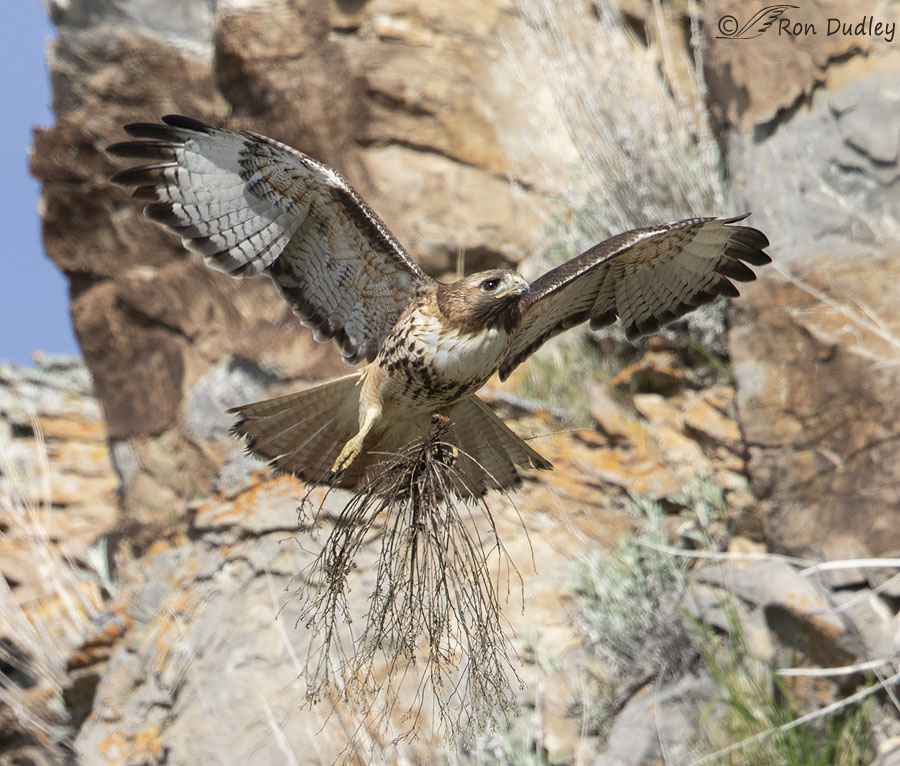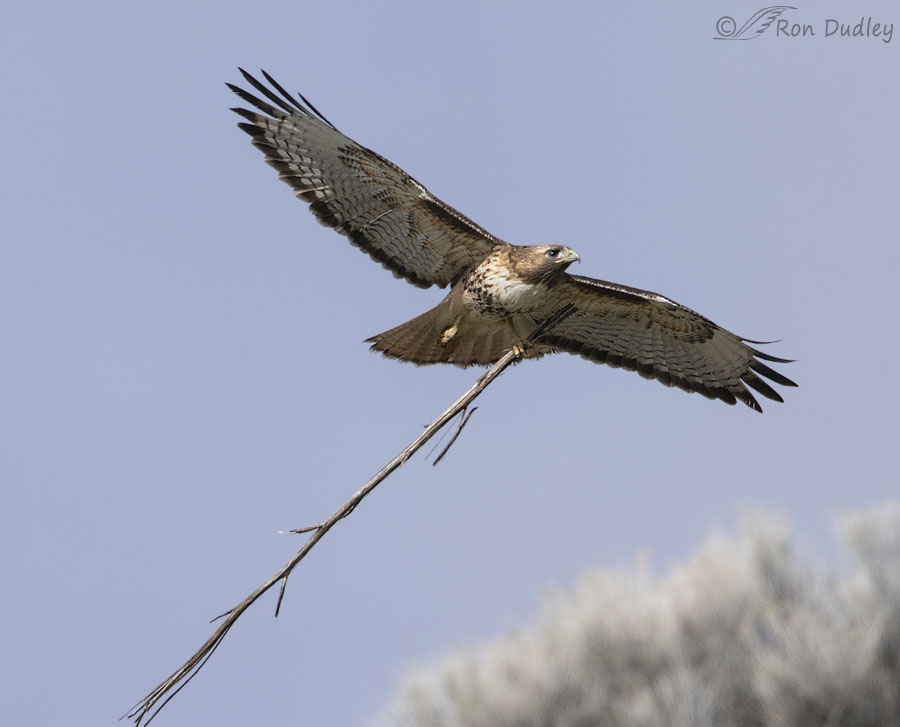Yesterday morning I found another pair of nest-building Red-tailed Hawks. Neither bird is a rufous color morph (like the female in the pair I’ve been photographing recently) but they’re still great photo subjects and I was able to document several interesting behaviors.

1/2000, f/6.3, ISO 500, Canon 7D Mark II, Canon EF 500mm f/4L IS II USM + EF 1.4 III Extender, not baited, set up or called in
I believe this is the male of the pair. All morning he was focused on carrying nesting material while his mate spent most of her time preening on a nearby rocky perch. I think he was trying to impress her with his industriousness.
I like this shot partly because it’s a little unusual. I typically don’t get a raptor with nesting material flying toward me with a cliff this close in the background because at this point they’re usually flying toward the nest with their back to me. And in this photo his flight angle put some light on his underside and that’s a plus. I wish his head was a little sharper but I think it’s acceptable.
This may look like a large and unwieldy piece of nesting material but for this bird it was chicken feed.

1/3200, f/6.3, ISO 500, Canon 7D Mark II, Canon EF 500mm f/4L IS II USM + EF 1.4 III Extender, not baited, set up or called in
Big hunks of “stuff” were his specialty. Here the stick (log?, pole?) he tackled was so long I couldn’t keep all of it in frame, in spite of trying to do so in quite a few photos as he flew toward the nest. This was as close to keeping the entire stick in the frame as I was able to manage.
I took almost 1500 photos of these birds yesterday and I’ve had very little time to review them but I should have more interesting behaviors to post over the next few weeks.
These birds obviously still aren’t incubating eggs and based on my observations of paired red-tails in other areas I’m convinced that they’re late this year compared to previous years. I suspect that may be due to our cold, wet spring.
Ron
Note: I spent my entire time with these hawks inside my pickup alongside a road and never approached the nest. I watched their behavior carefully and if my presence had altered that behavior I’d have left the area immediately. These birds are obviously acclimated to vehicle traffic and I was photographing them from a distance at an effective focal range of 1120mm. These photos have been significantly cropped..


Fascinating story. Beautiful shots. I never thought about whether hawks were lefties or righties before, That’s really neat but why wouldn’t they be? Other critters too, I would think. Otters must be, or maybe they’re ambidextrous?
What about Bobcats? I bet they go left or right. What about voles?
Lots of “what abouts”, aren’t there Dave. I’m so right handed I couldn’t wipe my…. nose with my left hand.
…You’re probably devoid of Arabian DNA then.
I am glad they are nesting somewhere because I noticed it was not where it had been (if this is the same pair) I was sad and worried.
They’re not the same pair, Suzanne. The female in this pair is not rufous.
How fun to catch the Hawk carrying materials to their nest. The long stick surprised me. Must be a fine looking nest. Really nice pics Ron. I especially enjoy the first picture.
Thanks, Jean. There’s a story to tell about “that” nest. I’ll save it for another post…
Ron, what an educational post. I looked up Red-Tail Hawk’s nesting information and found that the nest is usually built high above the ground or on the edge of a cliff [which you’ve shown us previously]. Cornell site said that nests can be 6.5′ high and 3′ across. Maybe those dimensions call for a big stick as you showed us in your photo. Thanks for the great post, Ron
They’re not all that large but they can be pretty big, Alice. Thanks.
I DID think the collection in the first photo was impressive until I scrolled down.
He obviously has plans for a McMansion.
Our cockatoos are left handed. Almost without exception I believe.
Fascinating shots, and I am really looking forward to more from this series.
Thanks, EC. I think I remember you mentioning your left-handed cockatoos on one of my “handedness” posts.
In the first photo it looks like he pulled an entire dead plant from the ground. I could use a hawk like that in my yard right now.
Looks like that is going to be one impressively big nest,
The tail feathers look pretty ragged at the ends; typical for this time of year?
Pretty typical In my experience, Lyle.
Your “pulling an entire dead plant from the ground” comment pretty much describes what I photographed him doing once. Stay tuned…
These are so interesting to study. He is quite industrious…determined to fulfill his duty. He has a driven look on his face. I see in both of these photos he is carrying the nesting material with the same foot…did he do that in the other photos you happened to get of him? Is that something they normally do; only use one foot to transport the material? Sure hope they have a successful family!
I’ll have to spend some time looking at my other 1500 photos of him and his mate to know the answer to that question, Kathy. But we do know that at least some birds exhibit “handedness” (a topic I’ve covered before on Feathered Photography) so I wouldn’t be surprised.
Thanks…Good to know…I’ve often wondered if they would have a propensity for one over the other. I’ll have search back in your posts…
Here’s a link, Kathy.
https://www.featheredphotography.com/blog/2016/03/17/short-eared-owls-and-handedness/
Wow. I would have thought he’d distribute the weight of the stick more evenly (as in carry it horizontally in both talons), but that might have messed up his ability to land with it. That is one “buff” bird! Thanks for these shots and I look forward to seeing what else you came up with.
“Thanks for these shots and I look forward to seeing what else you came up with”
Ha, so do I Marty! So far I’ve only looked at thumbnails of most of them. Been working on my blankety-blank taxes…
Beautiful photos, I need to pull up a thesaurus and start using more adjectives! Beautiful fits well. It is amazing how they can carry heavy, awkward loads and still fly.
I was hoping you were out yesterday. Despite the cloudy start it was a stunning morning. Once I could figure how to get out of Salt Lake through the damn Marathon I too headed for the field.
Thankfully I didn’t have to negotiate the marathon, April. I definitely have an opinion about them closing roads for running and cycling events and such things.
I’ll admit to using an online thesaurus regularly when composing my posts…
Very interesting…I’ve seen eagles with large pieces of nesting material, but have never seen smaller raptors carrying such big, heavy-looking or bulky stuff…
This fella was definitely a heavy-lifter, Patty.
Heavy and awkward…
It’s interesting your comment about the “lateness” of their nesting due to inclement weather. Here in Western Washington, a pair of bald eagles nesting near me have already given birth.
Bald Eagles are normally early nesters in the lower 48, Shelley. It takes them a long time for them to raise chicks to fledging.
True…they ptobably have laid their eggs last month…I wonder if something happened to their first nest and eggs and that this is a second try…
Patty, late nesting seems to be the pattern for red-tails around here this year.
Ron, my first version didn’t show up for 10 minutes. Please eliminate my second attempt.
Great action photos Ron. We’ve all see how large most raptor’s nests are. Can you imagine how many trips like these it takes to build one?
It takes a LOT of trips, Everett – even when birds are only refurbishing older nests. Thank you.
Ron, thanks for the care you take while photographing. I’ve read that birders and photographers have become so numerous and aggressive with birds, that the Cornell Lab is no longer publishing information about the locations of rare ones. Also the High Country News (an excellent and enjoyable magainze you are likely familiar with) published an editorial and article about how flowers are being trampled by those who want to be among them instead of on trails observing and/or photographing them. Someone even landed a helicopter on public land filled with flowers. How terribly sad for our increasingly abused and pver-humanned world.
Nancy, I think it’s vital to avoid disclosing locations of nests and rare or roosting birds (owls in particular) and especially to avoid approaching nests. I wish everyone would do the same. If our presence is significantly changing the behavior of our subjects we’re too close!
If that last shot is cropped and the stick was still clipped in the original shot, just how long was that branch! Great shots once again Ron!
It was pretty darned long, Xavier. That shot is cropped but I didn’t crop anything off the bottom of the frame.
He was a very busy boy!
He sure was.
Interesting! Could get VERY exciting if the hawk hit something with the long stick while in flight! Also wonder about “drag” flying with it. I know the raptors have to build large nests BUT seems strange to see them with the nesting material rather than prey of some sorts…… He does seem intent on his “job” of the moment. Wonderful documentation of beautiful birds, Ron.
Also wonder about “drag” flying with it. I know the raptors have to build large nests BUT seems strange to see them with the nesting material rather than prey of some sorts…… He does seem intent on his “job” of the moment. Wonderful documentation of beautiful birds, Ron. 
Judy, on other occasions when I saw him taking off with large or long pieces of nesting material it would sometimes drag and bump along the ground for a while before he was able to get fully airborne. He was a VERY hard worker and I hope his mate was duly impressed.